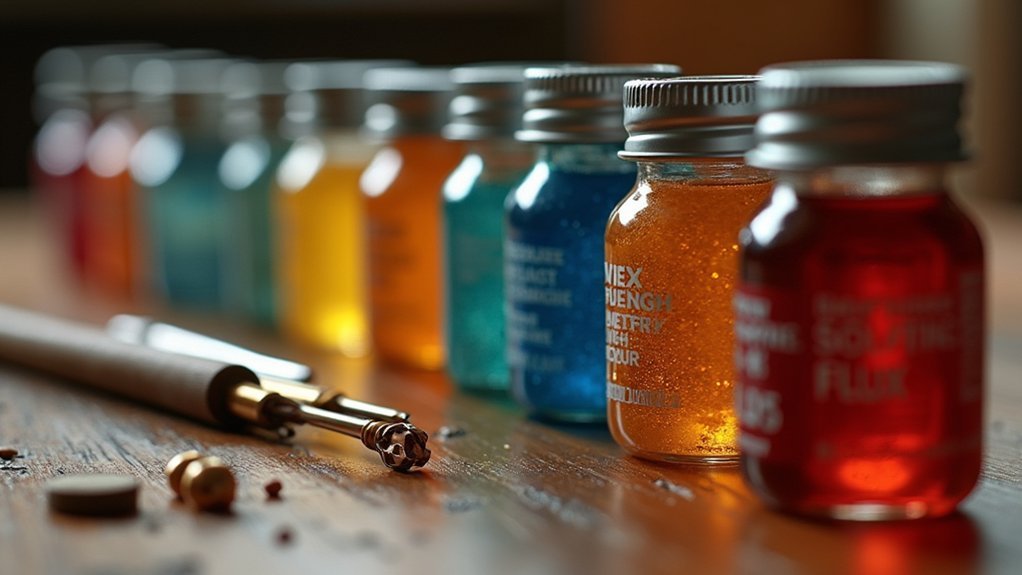You’ll achieve consistently strong, clean solder joints when you match your flux type to your specific metal and project requirements. Rosin-based flux delivers reliable performance for gold and silver with minimal corrosiveness, while water-soluble flux offers superior cleaning power for intricate designs and easy cleanup. No-clean flux streamlines your workflow by eliminating post-soldering cleaning while protecting sensitive gemstones. Activity levels matter too—mildly activated rosin works best for precious metals, while higher activity formulations suit platinum applications. Understanding these distinctions will transform your soldering results.
Understanding Flux Properties and Chemical Composition for Jewelry Applications

When working with precious metals in jewelry making, you’ll find that flux serves as your most critical ally in achieving clean, strong solder joints.
Understanding chemical composition helps you select the right flux type for your specific application. Rosin-based flux contains organic acids that effectively remove oxidation from metal surfaces while maintaining low corrosiveness—perfect for delicate precious metals.
Water-soluble flux offers superior cleaning power but requires thorough post-soldering rinsing to prevent corrosion. Both types create a protective barrier that prevents re-oxidation during the heating process.
Your success in jewelry soldering depends heavily on proper flux application, as insufficient coverage leads to weak joints and potential failure in your finished pieces.
Rosin-Based Flux Types and Their Performance in Precious Metal Work
Among the various flux options available, rosin-based formulations excel in precious metal applications because they deliver consistent cleaning power without the aggressive corrosiveness that can damage delicate gold and silver surfaces.
These rosin-based fluxes effectively remove oxides and contaminants, ensuring strong adhesion for high-quality solder joints on gold and silver pieces.
Rosin-based fluxes deliver superior oxide removal and contamination control, creating robust solder bonds essential for professional precious metal work.
You’ll find mildly activated rosin (RMA) flux particularly valuable in precious metal soldering, as it balances cleaning effectiveness with minimal residue production.
This reduces your post-soldering cleanup requirements considerably. The rosin creates a protective barrier during heating, helping prevent corrosion while extending joint longevity.
When selecting flux, consider the specific activity levels needed for your project.
Different formulations offer varying performance characteristics, allowing you to match the flux’s cleaning capabilities to your precious metal requirements.
Water-Soluble Flux Systems for Clean Jewelry Assembly

Water-soluble flux systems offer superior cleaning capabilities for jewelry assembly through their incorporation of organic acids that aggressively tackle metal surface contaminants. You’ll find these fluxes excel at creating strong solder joints by ensuring clean metal surfaces that promote ideal bonding. They’re particularly effective for intricate designs, facilitating better solder flow into tight spaces.
| Advantage | Benefit |
|---|---|
| Easy cleanup | Rinse with water removes residues |
| Environmental compliance | Meets environmental regulations standards |
| Superior aesthetics | Minimize contamination for polished results |
After soldering, you must rinse with water to remove all residues, preventing corrosion. These eco-friendly solutions enhance aesthetic quality while meeting strict environmental regulations. For jewelers prioritizing both performance and sustainability, water-soluble fluxes deliver exceptional results in professional jewelry assembly applications.
No-Clean Flux Solutions for Professional Jewelry Manufacturing
No-clean flux solutions revolutionize professional jewelry manufacturing by eliminating post-soldering cleaning requirements while maintaining exceptional joint quality.
You’ll find these specialized fluxes contain organic compounds that deliver excellent wetting properties, creating strong solder joints on gold, silver, and copper. The minimal residues they leave behind won’t corrode your finished pieces, preserving aesthetic quality without compromising functionality.
You can choose from various formulations including syringe applicators and flux core wires for precise application on intricate designs.
This flexibility enhances production efficiency by reducing cleanup time and protecting sensitive gemstones during metal soldering. When you’re working with delicate jewelry pieces, no-clean fluxes streamline your workflow while ensuring professional results that meet industry standards.
Selecting the Right Flux Activity Level for Different Jewelry Metals

How do you determine the ideal flux activity level when working with different jewelry metals? Your choice directly impacts oxide removal and strong solder joints quality. For precious metals like silver and gold, you’ll need mildly activated rosin (RMA flux) with medium activity levels. When working with sensitive metals or high-temperature applications, water-soluble flux provides the aggressive oxide removal you need.
| Jewelry Metal | Recommended Flux Type |
|---|---|
| Silver/Gold | Mildly Activated Rosin (RMA) |
| Aluminum | Water-Soluble Flux |
| Copper Alloys | No-Clean Flux |
| Platinum | High-Activity Rosin |
| Mixed Metals | Water-Soluble Flux |
Consider your solder type too—lead-free solder requires more active fluxes than traditional options. No-clean flux minimizes post-soldering cleanup while maintaining effectiveness for most jewelry metals.
Frequently Asked Questions
What Flux Is Used in Soldering of Metals?
You’ll use rosin flux for general soldering, no-clean flux when you want minimal residue, or water-soluble flux when you need high cleaning activity but can wash thoroughly afterward.
What Is the Best Flux for Soldering Galvanized Sheet Metal?
You’ll want water-soluble flux for galvanized sheet metal since it effectively removes zinc oxide and promotes strong adhesion. No-clean flux also works well if you prefer minimal cleanup afterward.
Which Flux Is Highly Corrosive and Must Be Perfectly Washed off After Soldering?
You’ll find water-soluble flux is highly corrosive and requires perfect cleaning after soldering. You must thoroughly wash off all residues with deionized water to prevent ionic contamination and circuit damage.
What Is the Difference Between Water Soluble Flux and Rosin Flux?
Water soluble flux uses organic acids requiring thorough water cleaning after soldering, while rosin flux derives from natural rosin, leaves non-corrosive residues, and doesn’t require cleaning in most applications.
In Summary
You’ll achieve the best soldering results by matching your flux type to your specific metal and project requirements. Don’t overlook the importance of activity levels—they’re essential for proper joint formation. Whether you’re using rosin-based, water-soluble, or no-clean formulations, you must consider your post-soldering cleanup needs and workspace constraints. Remember, the right flux makes the difference between amateur-looking joints and professional-quality jewelry work that’ll last generations.





Leave a Reply